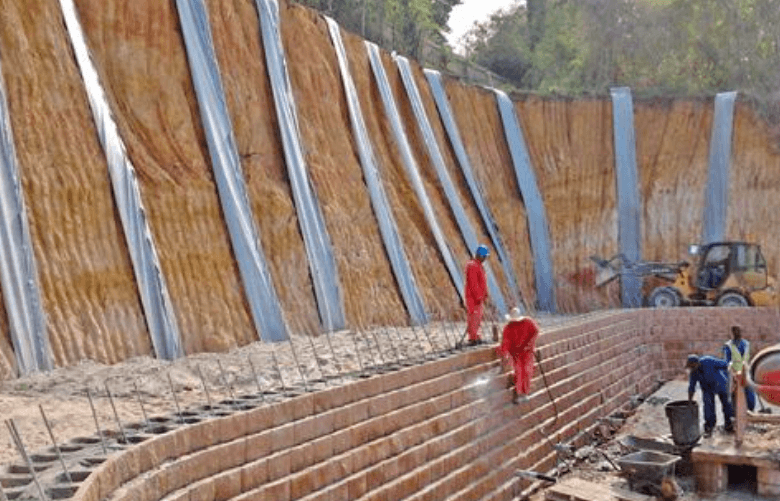
Modern Approaches to Retaining Wall Drainage and Soil Stability
Introduction
Retaining walls are vital structures in civil engineering, designed to hold back soil and prevent erosion in sloped or uneven landscapes. These walls must be built to withstand both the pressure of the soil and the impact of water accumulation behind them. One of the most effective and modern methods for enhancing the performance of retaining walls is by using geosynthetic materials. Specifically, the use of geotextile behind retaining wall structures has become a common and reliable technique. This addition not only improves wall stability but also ensures efficient drainage, extending the life of the structure significantly.
Understanding the Role of Geotextiles in Retaining Walls
A geotextile is a permeable synthetic fabric used in construction projects to separate, filter, reinforce, protect, or drain soil. When placed in retaining walls, it acts as a barrier that allows water to pass through while keeping soil particles in place. This helps prevent erosion and relieves hydrostatic pressure — two major causes of wall failure.
By installing geotextile behind retaining wall systems, engineers can achieve an effective balance between soil retention and water management. The fabric ensures that moisture drains efficiently without carrying away the fine soil particles that contribute to wall stability.
See also: Simplifying Business Setup in Hong Kong
Types of Geotextiles Used in Retaining Walls
Geotextiles come in two main types: woven and non-woven. Each serves a specific function in retaining wall construction.
1. Woven Geotextiles
These are made by interlacing synthetic fibers in a crisscross pattern, providing high tensile strength. Woven geotextiles are best suited for reinforcement purposes and are commonly used in applications requiring soil stabilization and load distribution.
2. Non-Woven Geotextiles
Non-woven geotextiles are manufactured using a bonding process that creates a felt-like structure. They are highly permeable and ideal for filtration and drainage. In retaining walls, non-woven fabrics are typically preferred because they allow water to flow freely while preventing soil erosion.
Importance of Installing Geotextile Behind Retaining Walls
Proper drainage and soil stabilization are key to the longevity and safety of retaining walls. The integration of geotextile behind retaining wall systems provides several important benefits:
1. Prevention of Soil Erosion
When rainwater or groundwater builds up behind a retaining wall, it can dislodge fine soil particles and weaken the foundation. The geotextile acts as a filter, allowing water to escape while holding soil in place, thus preventing erosion.
2. Reduction of Hydrostatic Pressure
Excess water behind a retaining wall geotextile behind retaining wall creates hydrostatic pressure, which can push the wall outward or cause it to collapse. The fabric helps relieve this pressure by allowing water to drain away effectively.
3. Improved Structural Stability
By maintaining proper drainage and separation of materials, geotextiles enhance the overall stability of the retaining wall. This ensures that the structure remains strong even under heavy loads or changing weather conditions.
4. Extended Lifespan of the Wall
A wall equipped with geotextile requires less maintenance and is less likely to experience cracking or bulging over time. The improved durability reduces the need for costly repairs in the future.
Installation Process of Geotextile Behind Retaining Walls
Correct installation is essential for achieving the maximum benefits of geotextile use. The process typically involves several steps:
- Excavation and Leveling: The area behind the wall is excavated and leveled to create space for the fabric and drainage materials.
- Placement of the Geotextile: The geotextile is unrolled and placed vertically behind the retaining wall, ensuring full coverage from the base to the top. It must be laid smoothly without folds or wrinkles.
- Adding Drainage Aggregate: A layer of gravel or crushed stone is placed in front of the fabric to aid water flow and protect the geotextile from damage.
- Connecting to Drainage Pipes: In some designs, perforated pipes are installed at the base to direct water away from the wall.
- Backfilling: Soil is compacted in layers behind the wall, ensuring the geotextile remains in position and maintains proper separation.
Factors to Consider When Using Geotextiles
To ensure effectiveness, several factors should be evaluated before and during installation.
1. Fabric Type and Quality
Choosing the right fabric depends on soil characteristics, expected water flow, and structural requirements. High-quality, durable geotextiles offer better resistance to clogging and degradation.
2. Soil Compatibility
Different soils interact differently with geotextiles. Fine-grained soils like clay may require fabrics with smaller pore sizes, while coarse soils such as sand need higher permeability fabrics.
3. Proper Drainage Design
Even with geotextile installed, a well-designed drainage system must be included to prevent water accumulation. Combining fabric with gravel layers and pipes ensures efficient water flow.
4. Environmental Conditions
In regions with high rainfall or groundwater levels, the fabric must be strong enough to withstand continuous moisture exposure without tearing or clogging.
Advantages Over Traditional Retaining Wall Systems
Traditional retaining wall systems often rely heavily on impermeable materials such as concrete, which can trap water and increase pressure. In contrast, incorporating geotextile behind retaining wall designs allows the system to manage both soil and water efficiently.
This innovation reduces the risk of structural failure and minimizes maintenance. Additionally, the lightweight and flexible nature of geotextiles simplifies installation compared to older, more rigid drainage methods.
Applications in Modern Construction
The use of geotextile behind retaining wall systems extends across multiple industries and applications, including:
- Highway and Road Embankments: To prevent soil erosion and manage water flow.
- Residential Projects: For garden walls, terraces, and landscape reinforcement.
- Riverbank Protection: To stabilize slopes and prevent sediment loss in waterway construction.
- Bridge and Tunnel Supports: To improve foundation stability and prevent soil displacement.
Future of Geosynthetics in Retaining Wall Design
The construction industry continues to evolve, and the role of geosynthetics, including geotextiles, is expected to grow further. Modern research focuses on developing fabrics with enhanced strength, better permeability, and improved environmental sustainability. Some new materials are even biodegradable, reducing the long-term ecological impact.
As digital technologies advance, monitoring systems integrated into retaining walls could help track water pressure and soil movement, ensuring proactive maintenance and longer wall lifespans.
Conclusion
The integration of geotextile behind retaining wall structures represents a smart and sustainable approach to modern construction. It effectively addresses the two biggest challenges in wall design—drainage and soil stability. By preventing erosion, relieving water pressure, and increasing durability, geotextiles ensure safer and longer-lasting retaining systems. As technology and material science continue to advance, the application of geotextile fabrics will remain a cornerstone of effective geotechnical engineering practices worldwide.



